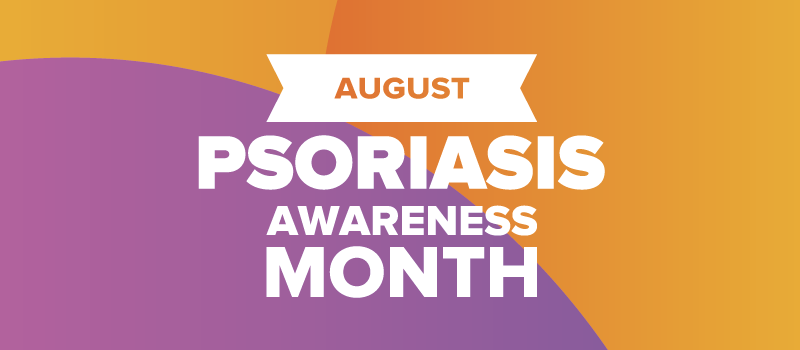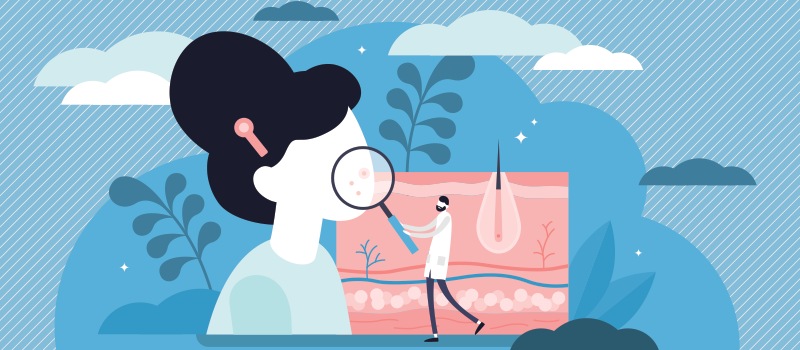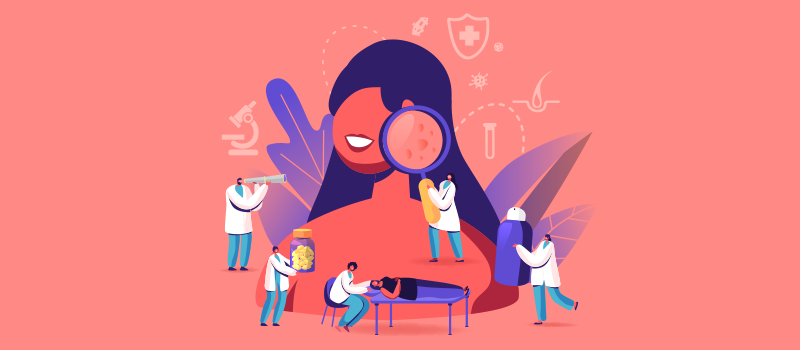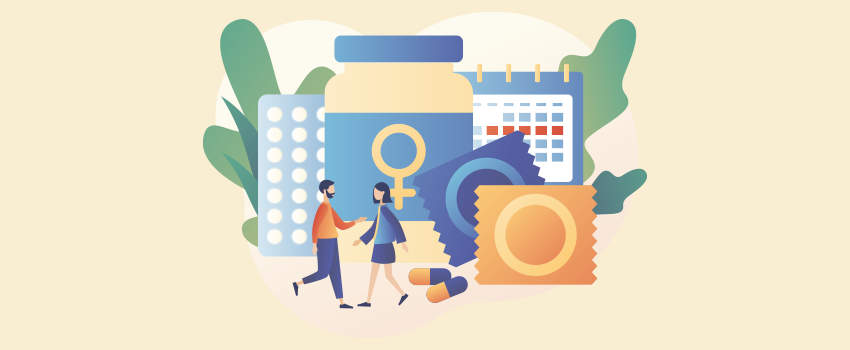What’s the Buzz
The Bee Healthy Blog
What Are the 4 Types of Acne?

Acne, also called acne vulgaris, is one of the most common skin diseases. It affects 8 out of 10 people at some point in their lifetime. Acne breakouts occur when pores (hair follicles) on the skin’s surface become blocked by sebum (an oily substance produced by glands in the skin) along with bacteria, dead skin cells, and other debris. The clogging of the hair follicle leads to the formation of various types of pimples.
Treating acne is important not only because the pink bumps cause pain and skin discoloration but also because if severe acne is left untreated, it can lead to acne scars.
Please continue reading to learn more about the different types of acne and medications used to treat acne.
What are the 3 causes of acne?
The three main causes of acne breakouts are:
- Oily skin (excess oil or sebum formation)
- Pores or hair follicles becoming clogged by debris (oil and dead skin cells)
- Bacterial infections leading to inflammation and skin irritation
Who is at risk of acne breakouts?
Teenagers are the most prone to developing acne. However, acne patients can range in age from pre-teens to people in their 50s and beyond.
Acne appears most commonly on the face, forehead, upper back, shoulders, and chest. These are areas where the skin surface has the maximum number of sebaceous (oil) glands.
What are the 4 types of acne?
People who have acne can develop various types of lesions (pimples). These lesions vary in type and number, depending on whether a person has mild or more severe acne.
Whiteheads
Whiteheads (medical term: closed comedones) are small, raised, flesh-colored bumps under the skin. They can appear as white bumps surrounded by red in people with lighter skin tones and dark or purple-colored bumps in darker skin types. Whiteheads do not usually cause scarring. However, the skin surrounding a large whitehead can become wrinkled and tight.
Blackheads
Blackheads (medical term: open comedones) are small, raised, dark-colored bumps in the skin that develop when whiteheads open. The darker color of blackheads is not due to trapped dirt. Rather, it is due to the effect of oxygen in the air on the contents of the comedones. The skin around a blackhead is usually normal.
Papules and Pustules
People with moderate to severe acne can develop inflamed lesions called papules and pustules (commonly called pimples or zits). Papules are small (less than 1 cm in size), solid, red, tender, and raised bumps with surrounding inflammation of the skin but no visible center or head. Pustules are larger and have a visible head with whitish/yellowish pus and inflammation of the surrounding skin.
Nodules and Cysts
People with severe acne develop lesions called nodules and cysts. Nodules are solid, hard, painful, raised, inflamed lumps under the surface of the skin without a visible head. Cysts are large, painful, red or white bumps that contain pus and are soft to the touch.
Each of the above types of lesions requires different acne treatments. It’s important to have your acne medically reviewed. Receiving timely and proper acne treatment can reduce your risk of long-term complications like scarring and pitting.
What are the 3 stages of acne severity?
Dermatologists classify acne into three stages—mild, moderate, or severe. There can also be intermediary stages like moderately severe acne. A person’s acne stage can change in response to stress, hormones, and other lifestyle factors.
- Mild acne consists of mostly whiteheads and blackheads with a few papules and pustules. The total number of acne lesions is less than 30.
- Moderate acne consists of more papules and pustules in addition to whiteheads and blackheads. The total number of acne lesions is more than 30 but less than 125.
- Severe acne consists of papules, pustules, nodules, and/or cysts. Acne scarring may also be present. The total number of acne lesions is over 125.
What makes acne worse?
Risk factors for acne include:
- Age. Teenagers are at the highest risk, although people of all ages can develop acne.
- Family history. Genetics is a key factor in the development of acne. If your parents had acne, your risk is higher.
- Hormonal changes. Acne breakouts are common during puberty and pregnancy, or with metabolic diseases such as PCOS
- Skincare products. The use of greasy or oily skincare products like lotions or creams can lead to acne flares. Non-oily cosmetics do not usually clog pores or interfere with the effectiveness of acne medication.
- Friction. Acne is not caused by poor hygiene or dirty skin. In fact, pressure on the skin from scrubbing too hard while cleansing or using harsh soaps can trigger acne. Also, friction from tight collars, helmets, backpacks, or cellphones can lead to acne.
- Medications. Certain medications like testosterone, corticosteroids, and lithium can cause or worsen acne.
- Diet. Certain foods, especially carbohydrate-rich foods like bagels, bread, and chips can worsen acne in some people. However, there is no evidence that greasy foods or chocolate affect acne.
- Stress. Stress does not cause acne but can make existing acne worse.
What are the treatment options for different types of acne?
Mild Acne Treatment
Over-the-counter treatments can improve acne that is mild and non-inflammatory (consisting of whiteheads, blackheads, and a few papules and pustules). These OTC acne treatments are available in the form of cleansers, rinses, toners, moisturizers, gels, and creams. They contain several active ingredients such as benzoyl peroxide, azelaic acid, salicylic acid, and adapalene.
In addition, the following home remedies can help achieve healthy skin:
- Cleansing the skin with mild soap and cool water twice a day
- Avoiding over-cleansing affected skin
- Staying well hydrated
- Avoiding unnecessary sun exposure
- Using sunscreen
- Avoiding touching or irritating the blemishes
Moderate Acne Treatment
In addition to the above measures, a doctor can prescribe medications to treat moderate acne (consisting of a larger number of papules and pustules). These include topical medications like dapsone and oral antibiotics.
Severe Acne Treatment
Moderate to severe acne requires treatment from a dermatologist or other healthcare provider. Acne treatments for severe forms (consisting of nodules and cysts) include:
- Prescription medications and systemic therapies like oral antibiotics (doxycycline, amoxicillin)
- Hormone therapy with birth control pills
- An oral retinoid (retinol, isotretinoin, alitretinoin, acitretin, bexarotene)
- Topical therapy with topical retinoids (adapalene, tretinoin, alitretinoin, tazarotene, trifarotene)
It is important to emphasize that these drugs must be taken strictly under medical supervision as they may cause undesirable adverse effects. Other acne treatments for severe cases include steroid injections to reduce inflammation, light therapy on the skin affected, and surgical drainage of large cysts.
Wrapping up
Acne is one of the most common skin conditions. It can cause affected people a great deal of self-consciousness and embarrassment. Mild acne can be treated with over-the-counter medications and lifestyle changes. However, it’s important to see a healthcare provider or clinical and aesthetic dermatology specialist for more severe forms of this skin disease. A doctor can properly diagnose acne and treat acne based on the type of acne you have.
References:












SOCIAL